

Transitions. What this handout is about In this crazy, mixed-up world of ours, transitions glue our ideas and our essays together.

This handout will introduce you to some useful transitional expressions and help you employ them effectively. The function and importance of transitions In both academic writing and professional writing, your goal is to convey information clearly and concisely, if not to convert the reader to your way of thinking. Transitions help you to achieve these goals by establishing logical connections between sentences, paragraphs, and sections of your papers. Transitions signal relationships between ideas—relationships such as: “Another example coming up—stay alert!” Transition words. To improve your writing you need to make sure that your ideas, both in sentences and paragraphs, stick together or have coherence and that the gap between ideas is bridged smoothly.

One way to do this is by using transitions - words or phrases or techniques that help bring two ideas together. Transitional words and phrases represent one way of gaining coherence. Certain words help continue an idea, indicate a shift of though or contrast, or sum up a conclusion. Check the following list of words to find those that will pull your sentences and paragraphs together. Types & Examples of Transitions. Plagiarism.org. Thesis Statements. What is a Thesis Statement?
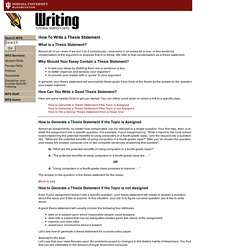
Almost all of us—even if we don’t do it consciously—look early in an essay for a one- or two-sentence condensation of the argument or analysis that is to follow. We refer to that condensation as a thesis statement. Thesis Statements. What this handout is about This handout describes what a thesis statement is, how thesis statements work in your writing, and how you can craft or refine one for your draft.
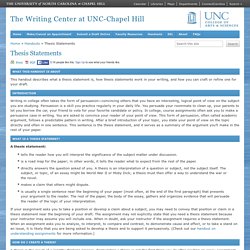
Introduction Writing in college often takes the form of persuasion—convincing others that you have an interesting, logical point of view on the subject you are studying. Creating a Thesis Statement. Summary: This resource provides tips for creating a thesis statement and examples of different types of thesis statements.
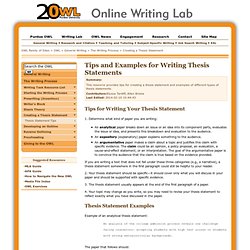
Contributors:Elyssa Tardiff, Allen BrizeeLast Edited: 2014-02-10 10:44:43 Tips for Writing Your Thesis Statement 1. Determine what kind of paper you are writing: An analytical paper breaks down an issue or an idea into its component parts, evaluates the issue or idea, and presents this breakdown and evaluation to the audience.An expository (explanatory) paper explains something to the audience.An argumentative paper makes a claim about a topic and justifies this claim with specific evidence. If you are writing a text that does not fall under these three categories (e.g., a narrative), a thesis statement somewhere in the first paragraph could still be helpful to your reader. 2. 3. 4.
Conclusions. What this handout is about This handout will explain the functions of conclusions, offer strategies for writing effective ones, help you evaluate conclusions you’ve drafted, and suggest approaches to avoid.
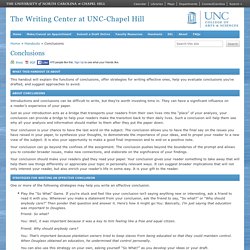
About conclusions Introductions and conclusions can be difficult to write, but they’re worth investing time in. 10 Steps to Writing an Essay. Recap your main idea If your essay was long and complex, sometimes difficult to follow, in the conclusion you'll want to recap your ideas in a clear, summarizing manner.
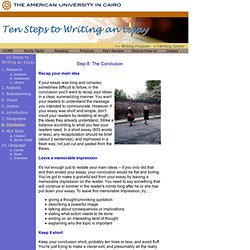
You want your readers to understand the message you intended to communicate. However, if your essay was short and simple, don't insult your readers by restating at length the ideas they already understand. Strike a balance according to what you feel your readers need. In a short essay (600 words or less), any recapitulation should be brief (about 2 sentences), and rephrased in a fresh way, not just cut and pasted from the thesis.
Writing Effective Conclusions. Writing Effective Conclusions (printable version here) A conclusion provides a thoughtful end to a piece of writing; unfortunately, many conclusions in college-level papers are little more than summaries of what has already been said.
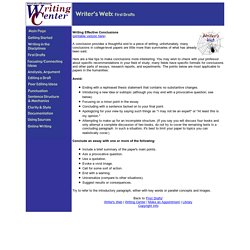
Here are a few tips to make conclusions more interesting. You may wish to check with your professor about specific recommendations in your field of study; many fields have specific formats for conclusions and other parts of essays, research reports, and experiments. The points below are most applicable to papers in the humanities: Avoid: Ending with a rephrased thesis statement that contains no substantive changes. Stylistic Devices (Rhetorical Devices, Figures of Speech) On the following pages, we will explain some of the most important stylistic devices (also called rhetorical devices or figures of speech) – they are not only useful for analysing texts, but also for creating your own texts.
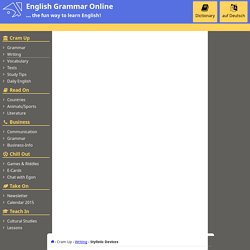
Stylistic devices make your speeches, essays etc. more interesting and lively and help you to get and keep your reader’s / listener’s attention. Stylistic Devices Alliteration Allusion Anaphora Antithesis Hyperbole Hypophora. English Homonyms. English Homonyms The following is a list of English homonyms.
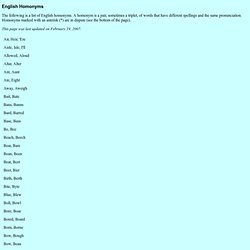
A homonym is a pair, sometimes a triplet, of words that have different spellings and the same pronunciation. Homonyms marked with an asterisk (*) are in dispute (see the bottom of the page). This page was last updated on February 19, 2007. Disputed Homonyms. Figures of repetition. Handouts: Research and Documenting Sources.